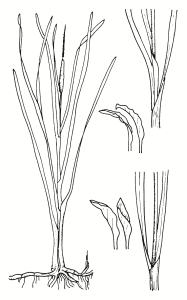Family:
Typhaceae
Typha spp.
Cumbungi
Other Names: Typha
First Nations Name(s):

Regional Subspecies:
Occurrence:
Regional:
Widespread and common throughout region.
Habitat & Site Selection:
Streams, swamps, lakes and local water-filled depressions, in fresh or slightly brackish water to 2 m deep. Salt tolerant.
Habit:
Erect robust semi-aquatic perennial. Vigorous, particularly during summer.
Similar Species:
Species in region include: Typha domingensis and T. orientalis. Both known as Cumbungi.
Seed Collection:
Seed is dispersed by wind and water. One seed spike can contain around 200,000 seeds, with a high percentage viable.
Propagation:
From seed or by division.
VALUES:
Land Protection:
Useful to extract pollutants from waste or drainage water. Reduces evaporation from swamps or shallow lakes as plants shelter the water surface from wind. A major weed of irrigation channels in western regions (outside of South West Slopes area). In shallow creeks dense stands slow water movement and cause flooding of surrounding land during high flows. To reduce the size of cumbungi stands, cut plants below the waterline in autumn.
Wildlife:
Excellent habitat for waterfowl and frogs.
